Each inner ear balance organ has five end organs: the three semicircular canals (anterior, posterior and horizontal canals) which sense rotation or “angular acceleration” and two gravity sensors (utricle and saccule) that sense “linear acceleration” including gravity. It is now possible to test all five end organs. Here are some tests we commonly use in clinic.
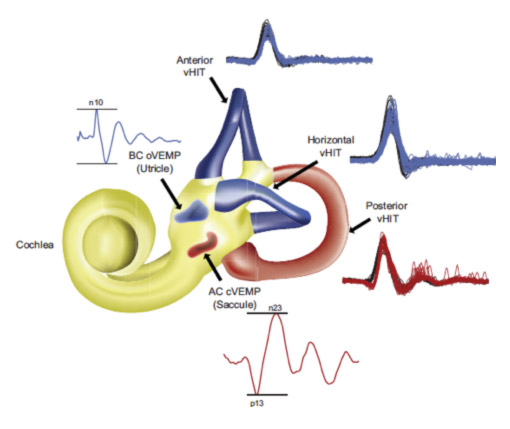
Suite 304 RPA Medical Centre, 100 Carillon Avenue, Newtown NSW 2042
-
Video Head Impulse Test (VHIT)
Our inner ear balance organs stabilise the visible world upon the retina as we move our heads during walking and running. This is achieved by the vestibulocular reflex, by means of powerful connections between the balance organs and the extraocular muscles which move the eye. The VHIT tests your ability to match rapid head movements with equal and opposite eye movements.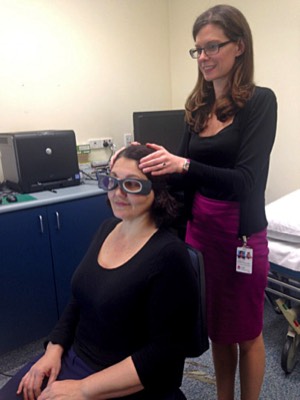
Method
You will be asked to sit upright and wear a pair of lightweight video-glasses. You will focus upon a fixed target. The examiner (an audiologist or doctor) will deliver 20 head turns in the direction of each semicircular canal. The speed of eye movement is measured and expressed as a fraction of the speed of head movement. This test is a valuable screening test of semicircular canal function.
Preparation
Do not wear mascara or eye-liner since these interfere with pupil tracking.
Time taken: 10 minutes -
Vestibular Evoked Myogenic Potentials (VEMP)
The gravity sensors of our inner ear balance organs have retained their primitive ability to be activated by sound and vibration. The VEMP test exploits this sound and vibration sensitivity to assess the integrity of our gravity sensors.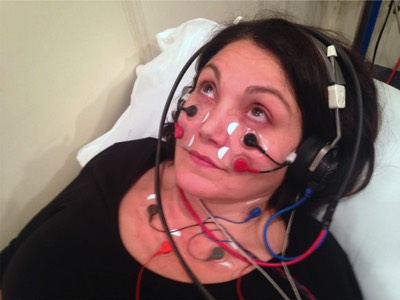
Method
Surface electrodes (like ECG dots) will be applied to the skin directly underlying your lower eyelids and over your neck muscles. You may be asked to look upwards or to elevate your head 45 degrees above horizontal. You will be asked to listen to clicking noises through headphones. Alternately, vibration pulses will be delivered over your forehead at 3 pulses per second. The recordings taken from your neck muscles or eye muscles give us useful information about your gravity sensors.
Preparation
None
Time taken: 10 minutes -
The Bithermal Caloric Test
While lying semi recumbent on a bed, dark goggles will be placed on your eyes and a small infrared camera records your eye movements. The test involves irrigating the external ear canal with warm and cool water for 40 seconds; you will experience a sensation of tilting or turning as your balance organs are stimulated by the water. You may also notice your eyes flicking in response to the stimulus (nystagmus). The velocity of these eye movements is recorded and compared for left and right ear stimulation. It is important to keep your eyes open and to remain alert during the test. The nurses who perform the test are highly skilled and will ensure that you feel safe and comfortable during the test. They may also engage you in conversation to ensure you stay awake.
Preparation
You will need see your general practitioner one week before the test to ensure there is no wax in your ears, and you must not eat or drink for 4 hours before the test. Diabetic patients could request an early morning (8.30 AM) appointment, take their regular hypoglycaemic tablets before the test and ensure they have breakfast when the test is completed. Patients on Insulin should delay the morning insulin dose until just before breakfast. If you are given a later appointment, you could eat an early (~5AM) breakfast and take your insulin/tablets before breakfast. Medications specifically taken to quell an attack of vertigo such as prochlorperazine ("stemetil") or Cinnarizine ("stugeron") should be withheld for 48 hours before the test. If you are a long term user of sedatives, please speak to your doctor to check if these can be withdrawn. All other medications including migraine prevention drugs, pain killers and cardiac medications should be taken with a sip of water, on-time as prescribed.
Time taken: 30-60 minutes -
Auditory Brainstem Response (ABR)
This is an extension of the standard hearing test, and further measures the auditory nerve from the ear (cochlea organ) to the brain. It is a relatively simple and non-invasive test.
Method
The audiologist will first cleanse the skin on the forehead and ears and will place very small recordings cups onto the head and earlobes with gel. Then the patient lies comfortably on a bed with their eyes closed, in a darkened room, as clicking sounds are played for about 5 minutes into each ear separately. The recording cups measure brain activity which help to determine how the brain is hearing and processing the sounds, and so there is no response needed from the patient.
Preparation
None
Time taken: Approximately 30 minutes
-
Bias Testing (Subjective Visual Horizontal Test)
This test measures a person's ability to determine what is 'level', and is a test of our gravity-sensing balance organs (the otolith organs) and how they work with our eyes.
Method
In this test, the patient sits in a darkened room where a small bar of light sits in front of them. The light bar is then tilted to different degrees off-centre, and the patient must use a handheld remote control to tilt the bar of light back to what they feel is perfectly flat to the horizon. The test is repeated 10 times for each eye separately.
Preparation
None
Time taken: Approximately 10 minutes -
Rotational Chair Test
This test is an additional measure of lateral semicircular canal function and uses our vestibulo-ocular reflex (VOR). It is also used to assess VOR suppression (by bright light) in central vestibular / cerebellar disorders.
Method
The patient sits on a chair and is fitted with dark goggles with a small camera to record eye movements as they are slowly turned in the motorised chair.
Preparation
You must not eat or drink for 3 hours before the test. Diabetic patients should request a morning appointment and take their regular hypoglycaemic tablets before the test and ensure they have breakfast when the test is completed. Patients on Insulin should delay the morning dose until just before breakfast. Medications specifically taken to quell an attack of vertigo such as prochlorperazine ("stemetil") should be withheld for 48 hours before the test. If you are a long term user of sedatives, please speak to your doctor to check if these can be withdrawn. All other medications including migraine prevention drugs and cardiac medications should be taken with a sip of water, on-time as prescribed.
Time taken: Approximately 15 minutes -
Audiometry (Hearing Test)
Your hearing threshold provides valuable clues to the origins of vertigo. A hearing test is therefore an essential component of balance testing. Screening audiometry takes only 20 minutes. Audiometry with impedance and speech testing takes 40 minutes.
Preparation
Your ears will need to be clear of wax
Time taken: 20 minutes for screening
Time taken: 40 minutes with impedance and speech testing -
Trans Tympanic Electrocochleography
This test measures the distortion of inner ear membranes (linings) caused by the presence of excess inner ear fluid. It is useful in the diagnosis of Meniere's Disease and related disorders.
The test is performed by an expert otolaryngologist and involves placing a thin wire (electrode) through a small piercing that is made in a safe place on the ear drum. The ear drum is anaesthetised beforehand. During the test, noises (clicks or tones of specific frequencies) are presented through headphones.
After the test, patients are advised to keep the ear dry for one week. -
Home Video Goggles
It is often challenging to see us when you are acutely dizzy. When you are dizzy, however, your eyes will generate movements called nystagmus that help us diagnose vestibular disorders with greater accuracy. Our clinic offers custom-made miniature take-home video goggles that will enable you to record your eye movements whilst acutely dizzy at home. You will receive training on how to use these during your appointment.
Preparation
Ensure you are in a safe environment and have a support person with you prior to putting on the goggles as you will be unable to see with them on.
Time taken: 5 minutes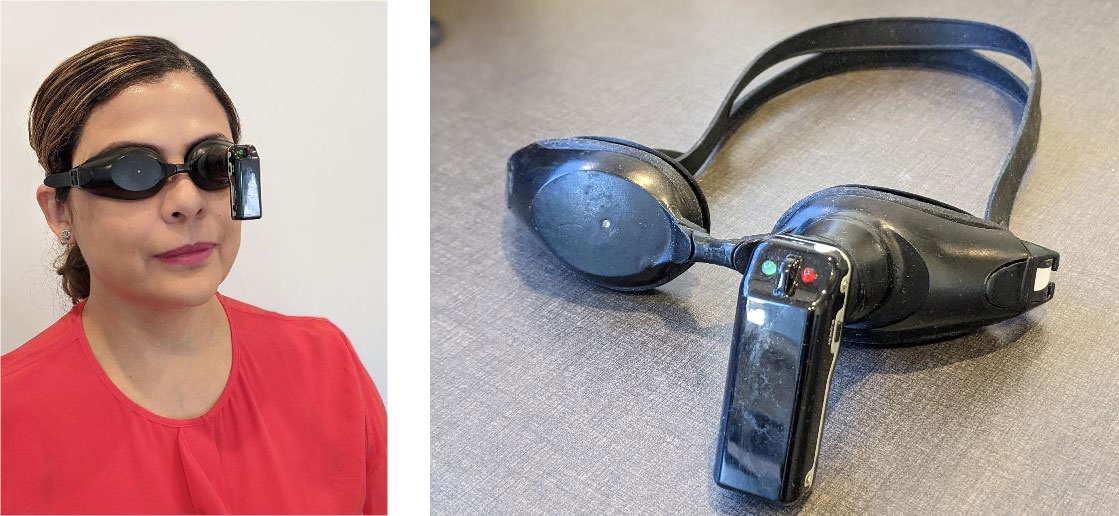
-
Home Audiometry
Some vestibular disorders are associated with changes in hearing. To help capture this, we offer portable iPad audiometer kits for loan, so that you can measure your own hearing at home. You will be trained on how to use this equipment during your appointment.
Preparation
You will need to find a quiet place to conduct the hearing test
Time taken: 20 minutes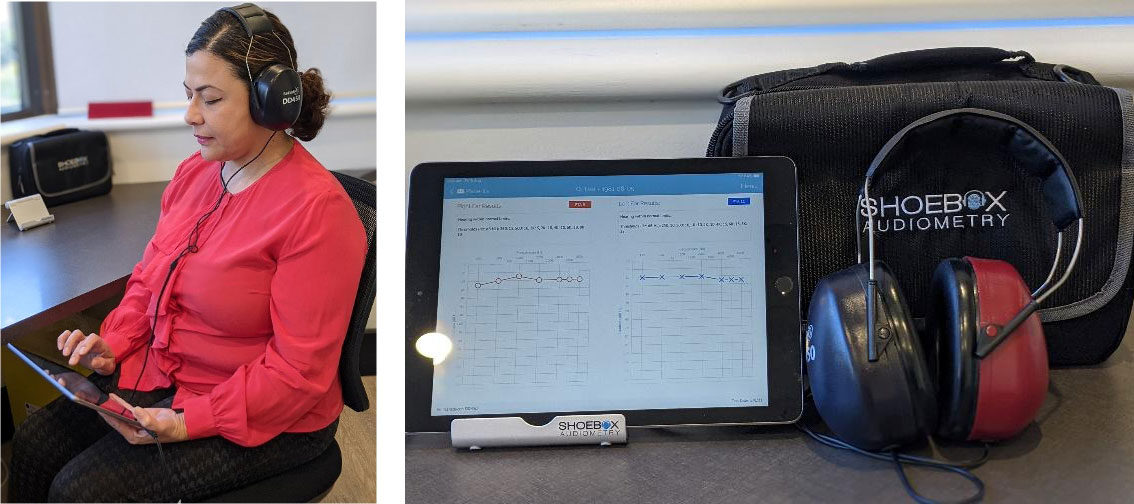
Suite 304 RPA Medical Centre
100 Carillon Avenue
Newtown NSW 2042
For urgent referrals please message / call 0478 183 126. Our aim is to see all urgent referrals ASAP.
admin@balanceclinic.com.au
FAX 02 8330 6323
Please note a referral is needed before appointments are made, in order to ensure you are offered the correct service for your medical problem.